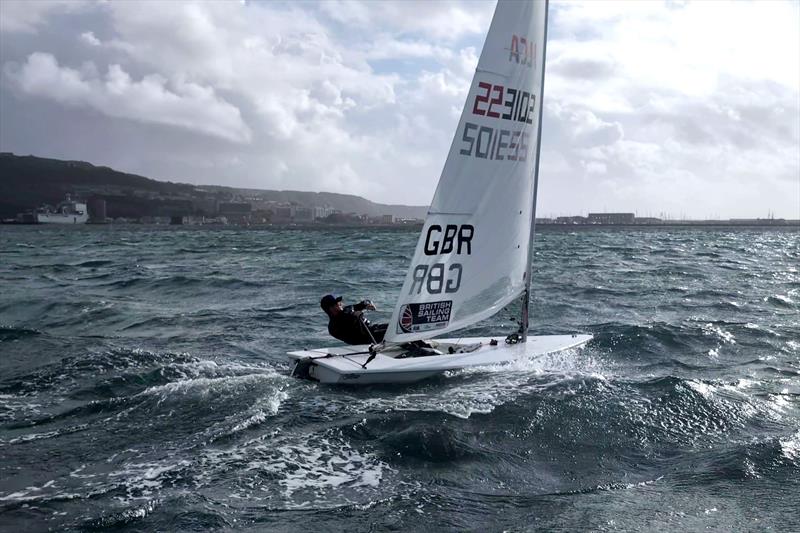
Dinghy Sailors - How to Get the Most Out of Winter Training
by Cyclops Marine 8 Nov 01:00 NZDT

ILCA dinghy using load sensors © Cyclops Marine
Got a training plan for the winter?
There are lots of things to think about: starts, tacks, gybes, mark roundings, manoeuvres, and of course sheer boat speed. But it's better to think about some of these closer to the season, when you start simulating race conditions and re-sharpen your tactical awareness and decision making.
For now, there's no better time to focus on boat speed and performance tuning, so that when you come to refine manoeuvres and tactics you're already a few clicks faster going in.
Now is the time to keep it simple and monitor your progress.
"Winter sailing strips out the noise. It's an opportunity to go back to the drawing board. You don't have to worry about the next race, so try things, vary things and discover new gears that you can refine and repeat — turning fast setups into repeatable data points." - Ben Hazeldine, Pro Sailor, Cyclops Expert
Boat Speed: What to Work On
When you're maximising boat speed, three of the main things you'll focus on are rig tension, sail shape, and trim in different conditions.
Depending on your class, the critical controls you're looking at to impact these will be different. Traditionally, you'd vary these controls by feel — a process of trial and error, trying to repeat what felt fast. But as soon as you start monitoring loads accurately, with a wireless load sensor paired with a mobile app, you can actually record and recreate your fastest settings, immediately identifying points for improvement. Stop juggling theories in your head and start turning them into tangible, measurable gains.
On an ILCA, for instance:
Vang (Kicker):
- Higher vang load tightens the leech and flattens the sail - reducing twist and depowering the top of the main
- Performance impact:
- In strong wind, controlling vang load helps balance power and prevent excess heel.
- In lighter breeze, easing vang (lower load) opens the leech for acceleration.
* The Cyclops effect: Measuring vang load helps to reveal when you're applying power upwind or through gusts — and whether you're repeating your fast setup.
Cunningham (Downhaul):
- Adjusts luff tension — depowers the mainsail as it pulls the draft position forward and flattens the sail.
- Performance impact:
- Too little = draft too deep = power but drag and weather helm.
- Too much = overly flat sail = loss of power and acceleration.
* The Cyclops effect: Monitoring downhaul load helps identify your optimal power point — where lift and pointing balance.
Outhaul:
- Flattens or powers up the lower third of the sail.
- Higher outhaul load flattens the sail's foot (less depth = less drag).
- Performance impact:
- Eased (low load) for light wind or offwind legs = more depth and drive.
- Tightened (high load) for upwind or strong breeze = flatter, lower-drag shape.
* The Cyclops effect: Monitoring outhaul load helps quantify "feel" — so you can repeat your fastest lower sail shape.
Monitoring your loads
Each of these controls - and any other soft line onboard dinghies - can be monitored by Cyclops' smartlink2 Atto - the most affordable wireless load sensor on the market.
Weighing just 75g, it measures loads up to 250kg, accurate to within 1% of maximum working load, making it ideal for dinghy and sportboat racing, as well as windsurfing and kitesurfing.
Harnessing your data
The Atto sends live load data via Bluetooth to the Cyclops app and/or Vakaros Atlas 2 instrumentation. You can use the live load data to practice hitting and repeating your fastest settings while sailing, or even mark up your jib sheets in different colours to make hitting optimal settings super easy come the season.
Post Sail Analysis
Whether or not you're set up to view live data on your phone or Vakaros Atlas 2, the Cyclops app and a range of third party apps can capture your data in the background for post sail analysis—which is where you'll get the most value for winter training.
The Cyclops App
The Cyclops app will automatically log load data across your session, it's great for accurate two boat tuning and finding and improving on your fastest settings.
We met up with two Junior National Champions to compare their Sprit loads...
Deeper Debrief and Development
To get even more out of your training, you can integrate your load data with other inputs that affect boat speed, like heel, pitch, and GPS. There are a range of fantastic apps that let you do this, like SailViewer and Vantage. Both seamlessly integrate Cyclops data and offer great features that make analysis simple and valuable, also allowing you to share and compare with friends.
A lot of sailors use video overlay to see how their loads were impacted by their actions while sailing. This feature is available through SailViewer and other services like SailNjord.
See what Mozzy Sails discovered about his Europe Dinghy over a winter training with Cyclops and SailNjord:
The Data Advantage, for Everyone
You no longer need a professional coach to get to the next level. These affordable tools are making precision training accessible to everyone. Winter training is your opportunity to get a baseline of numbers for different conditions. Start now and when the season rolls around, you won't be facing a blank slate - you'll be armed with logged loads, exact targets to hit, and performance trends to convert into race wins.
Buy the Atto now and make every session count.